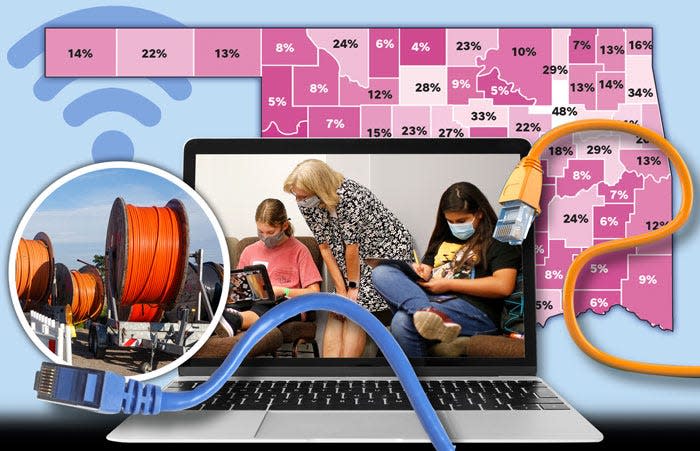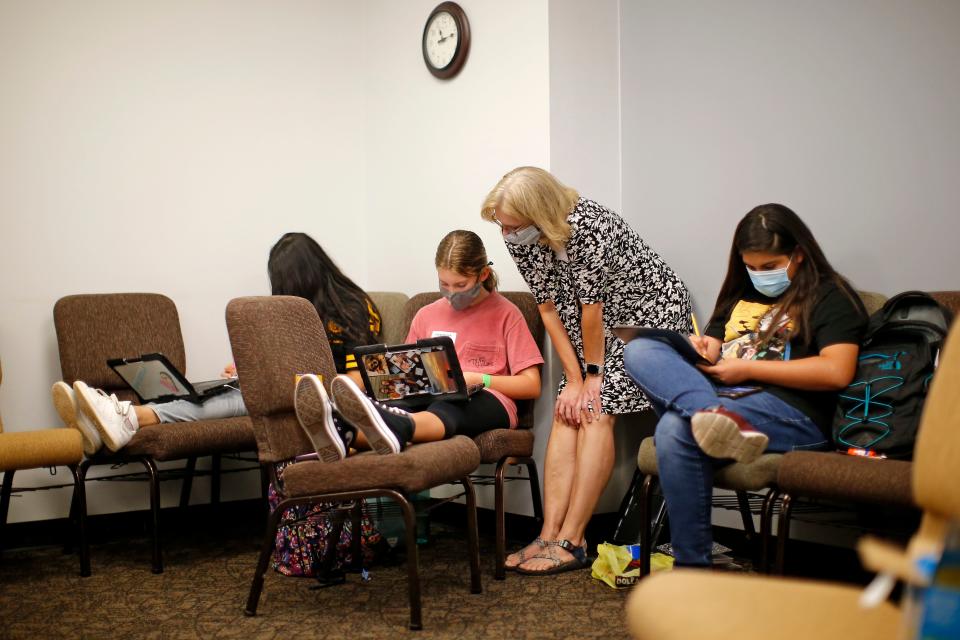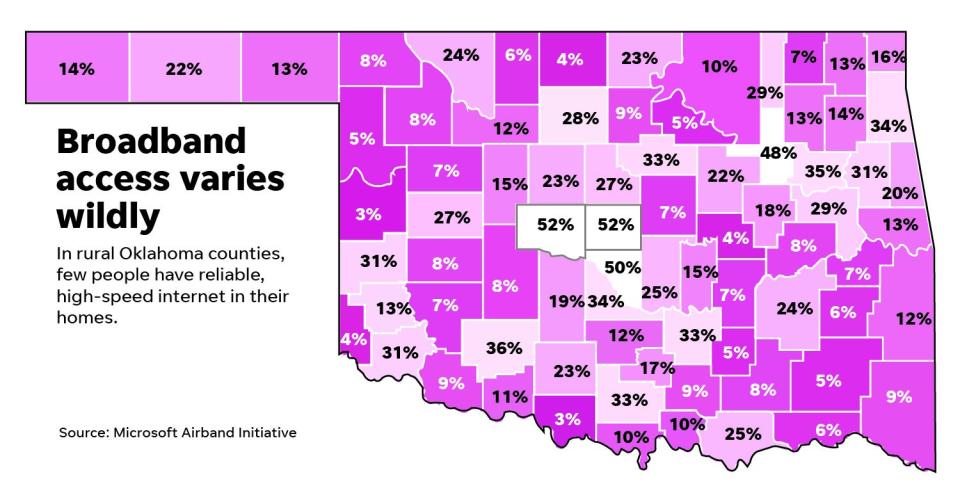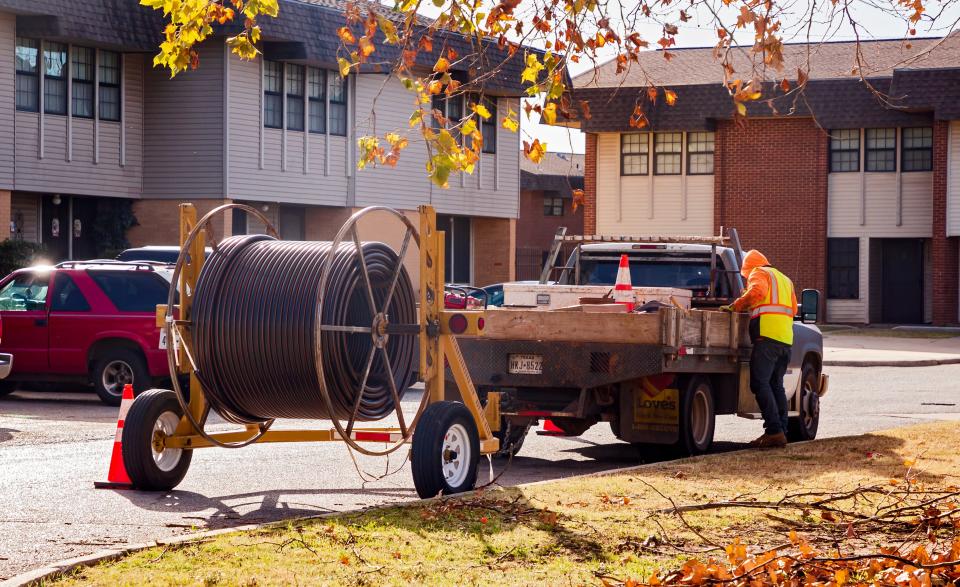Amped internet: New broadband service map sets stage for growth across Oklahoma
A map of available broadband service across Oklahoma just went from analog to high definition.

The map allows Oklahomans to click where they live or work and learn how speedy of internet service they can get.
The information isn't important to just Oklahomans, though. It also establishes a starting point for federal and state partners who will use the data to develop and implement a plan to upgrade internet services to make them capable of supporting everyone's needs.
The $65 billion paying for that upgrade comes through the federal Infrastructure Investment and Jobs Act, which aims to ensure every American has access to reliable, high-speed internet.
In Oklahoma, officials expect to have about $1.5 billion to use to boost internet accessibility for residents across the state, including those who already enjoy service, mostly in the Oklahoma City and Tulsa metro areas, that meets or exceeds federal acceptable standards.
Any improvement at all would be welcomed by Karen Carter, a virtual schoolteacher and mother of three in northwest Oklahoma City whose family struggled with connectivity issues during 2020's COVID-19 pandemic.
Carter, whose family gets its internet services through a cable service provider, described that experience as "extremely difficult."
More:Oklahoma man suing state over law limiting wind farms on his property

There were times during "internet rush hours" when service was very, very slow or inoperable because of unscheduled outages, she said.
The Carters required their children to take care of their school-related work early each day and then stay off their internet-connected computers, laptops and phones until later, after she and her husband were done with what they needed to for their jobs.
For students living in more rural areas of Oklahoma, Carter said reliable internet services needs are dire, in part because the state's educational system has migrated toward using internet-based materials to educate Oklahoma's youths over the past two decades.
While most students were equipped with iPads or laptops they could take home for use outside of class when the pandemic struck, many in rural areas had difficulty finding reliable internet service they could pair their hardware with to get classwork completed.
"The old educational model where a teacher stood in front of a class and talked and students did their homework at home has gone away, to some degree," Carter said. "As a parent and as a teacher, having access to affordable and reliable broadband services will be huge. It opens doors for children who need it desperately."
Map signals 'Highway to high-speed broadband' onramp
Oklahoma's efforts to upgrade internet services will be led by the Oklahoma Broadband Governing Board and the Oklahoma Broadband Office.
More:Oklahoma City stores open for Black Friday, and some that are closed

Mike Fina, who leads the board, said the amount of money the state ultimately will have to upgrade service will be calculated using work the FCC has done with internet service providers to capture what services they provide. Oklahoma will be given the opportunity to verify the data's accuracy before allocation amounts are finalized.
Anyone on the map that can't get internet service of at least 25 megabytes per second of download capability and 3 megabytes per second of upload capability will be classified as being unserved and will be targeted for improvement.
Fina said he wouldn't be surprised to learn more than half of the state's households and businesses fall into that unserved category.
To change that, copper wire systems used in most areas of Oklahoma to transmit internet data today must be replaced with faster fiber-optic cables.
Oklahoma will pull money to improve internet services from various sources, including $382 million in American Rescue Plan Act funds, $167 million from a capital projects fund and about $1 billion from the infrastructure act.
It also will draw $800,000 from a Digital Equity Access fund to improve Oklahomans' understanding of digital services and ways they can be accessed, and will work with entities receiving funds through a ReConnect program administered by the U.S. Department of Agriculture.
ReConnect already has been paying for upgrade projects happening across parts of rural Oklahoma, including ones that will start soon thanks to a recent allocation of $85.7 million made through the state's USDA development office headed by Director Kenneth Corn.
The broadband board and office will consider funding five types of upgrades to boost available internet services to "gig-squared" capacity, meaning a system capable of providing download/upload speeds of a gigabyte per second.
More:Abandoned dam in Oklahoma City a threat to life and property for more than 20 years
In order of preference, they include bringing it directly into a home or business using in-ground cable or through above ground cable that follows power lines, providing it wirelessly, using existing copper cable and digital subscriber lines (which limits upgrade capabilities), using satellite signals or using digital signals broadcast by television stations.
State leaders' immediate tasks are to develop parameters to evaluate, fund and audit installation projects, as "a ton of reporting on every dollar that we hand out will be required," Fina said.
"Toward the end of November, we expect to have a better understanding of the current state of data transmission capabilities across the state," Fina said.
The program, he said, aims to act as a "highway to high-speed broadband."
Rob Griffin, a member of the Choctaw Nation of Oklahoma who is its tribal broadband coordinator, said it will be key for the board and office to work with stakeholders across the state to ensure no one is left behind.
"We want to make sure everyone gets funded appropriately so that we don't have some areas where funds overlapped or worse, other areas where people aren't able to get that improved service and are stuck paying the bill for getting the work done," Griffin said.
Upgrades key to supporting rural growth
While Carter is certain switching her internet from cable to fiber would boost its performance markedly, those upgrades usually have even bigger impacts for rural Oklahoma users.

Especially for businesses, improved connection speeds impacts their productivity and profitability.
Jo Anne Battles and Mike Dunn, the controller and mill manager at Teal-Jones Lumber located near Antlers, said their operation has struggled the past 20 years without reliable internet service, leaving it at times without even functioning telephones or email.
But earlier this month, they said the mill was about to have a fiber line from Antlers activated capable of providing it with much faster, reliable internet.
The fiber-based service was brought to Antlers through an earlier ReConnect project. Teal-Jones then paid to have a line extended to its facility, they said.
While Battles and Dunn said it took several years and considerable expense to get the service to their operation, they said the gig-squared internet it will provide means everything.
"We have more computerization in the equipment we use today than we had even just 15 years ago, so having that speed connection is paramount to running well," Dunn said. "All of our machines are (computer) controlled, and we have to have vendors dial in to troubleshoot problems or upgrade software from time to time.
Improved connectivity also will make it possible for Teal-Jones to implement a digital, cloud-based inventory system.
The $24.6 million allocated for projects in McCurtain, Le Flore and Pushmataha counties as part of the latest ReConnect funding will provide an additional 4,000 people, 450 farms and more than 80 businesses across the area with vastly improved broadband connectivity, Griffin said.
"As southeastern Oklahoma grows and more people come, it is important that we have the capability to build businesses and an economy to attract even more people there," Griffin said.
Electric cooperatives also involved in upgrades
Beyond for-profit internet service providers, electric cooperatives in certain parts of Oklahoma also are providing fiber internet to customers.
The Oklahoma Association of Electric Cooperatives reports that 10 of its members have created fiber subsidiaries that have installed more than 17,500 miles of fiber and are serving more than 86,000 customers, so far.
One of the biggest cooperatives involved in that work is the Oklahoma Electric Cooperative that's headquartered in Norman and led by CEO Patrick Grace.
That cooperative was uniquely situated to launch a fiber subsidiary in 2018 because the areas it serves across parts of Caddo, Cleveland, Grady, McClain and Pottawatomie counties and includes people in densely enough populated areas who are willing to pay for big-city services, Grace said.
Not all cooperatives are blessed with the same situations, and some, after conducting feasibility studies, concluded they couldn't affordably provide the service. Being able to tap federal dollars will make a difference for many, Grace predicted.
"The federal dollars provided through the state can bridge that gap between what is feasible and what is not and get that going," he said.
Where will Oklahoma be in five years?
State leaders are confident that quality broadband access will be available to more Oklahomans five years from now.
The coming federal dollars will help enable internet providers across the state deploy systems that previously would not have met their needed returns on investment or total costs of ownership, they said.
Those hopes, however, are tempered by worries about acquiring fiber cable and other needed equipment because of ongoing supply-chain issues, plus a dearth of qualified workers to install what's needed.
The Choctaw Nation's Griffin said it and various other entities across the state are working with educational professionals on plans to help address that latter issue.
"There are a lot of jobs to be had," Griffin said. "We have got a great opportunity. We just are going to have to work hard."

This article originally appeared on Oklahoman: Map sets pathways to gig-sized internet services across Oklahoma

